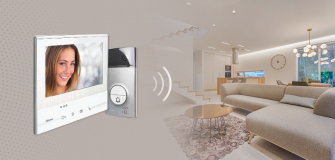Legrand’s KNX Automation: Designing Intelligent Architectural Spaces
In the rapidly evolving world of architectural design, technology has become an indispensable tool for creating aesthetically pleasing but intelligent and sustainable spaces. One technology at the forefront of this transformation is KNX, a standardised communication protocol for Home and building automation.
This blog will explore how Legrand’s KNX technology revolutionises architectural spaces, enhances user experiences, and promotes sustainable urban design.
Legrand’s KNX System and Its Applications:
KNX-based lighting control systems stand out for their versatility and compatibility, making them an ideal choice for architects and lighting control/automation consultants. It integrates various systems into a unified and interconnected network, such as lighting, heating, ventilation, air conditioning, security, etc. This capability empowers architects to design spaces that seamlessly respond to occupants’ needs while maximising energy efficiency.
Legrand, a renowned leader in electrical and digital building infrastructures, has harnessed KNX-based lighting control systems to create smart environments that adapt to the ever-changing demands of modern living.
Enhancing Architectural Spaces through Lighting Control:
One of the most significant advantages of KNX-enabled architectural design is Efficient lighting systems. By integrating KNX devices and sensors, architects can create spaces that intelligently adjust lighting levels, room temperature, and even security settings based on occupancy and time of day. It enhances comfort and significantly reduces energy consumption by ensuring that resources are used only when necessary.
Furthermore, KNX technology offers centralised control, enabling users to manage all connected systems through a single interface. This user-friendly approach simplifies daily interactions with the space and empowers users to personalise their environment according to their preferences.
Seamless Architectural Integration:
One of the remarkable aspects of Legrand’s KNX technology is its adaptability to various architectural styles and layouts. Whether a contemporary urban penthouse or a traditional countryside villa, KNX automation seamlessly integrates with the architecture, complementing the design rather than overpowering it. It makes it an ideal choice for architects seeking to maintain the aesthetic integrity of their projects while incorporating cutting-edge technology.
Consider a modern office building where KNX-enabled lighting adjusts its intensity based on the amount of natural light entering the space. It enhances the work environment and contributes to the building’s energy efficiency by minimising artificial lighting usage.
Customisation and User Experience:
Architects can leverage KNX-based systems to provide tailored user experiences that cater to individual preferences. For instance, a smart home with KNX automation can learn occupants’ behaviour patterns and adjust lighting and climate settings accordingly. This level of customisation creates a comfortable and intuitive living experience, enhancing occupants’ quality of life.
Urban Design and Sustainability:
In urban design, Legrand’s KNX technology is pivotal in promoting sustainability. The ability to manage lighting, heating, and cooling systems with precision ensures that energy is used efficiently, reducing the carbon footprint of buildings. It is particularly crucial in densely populated metro cities where energy consumption is high.
Case studies of urban projects reveal the potential of KNX technology in action. Imagine a space where lights automatically adjust their brightness based on the Lux levels, leading to reduced energy consumption while maintaining safety and visibility.
Legrand’s Innovations:
Legrand, a pioneer in advancing architectural integration through KNX technology and a world leader in electrical and digital building infrastructures, has been instrumental in this development. With a wide range of KNX-enabled devices and solutions, Legrand empowers architects to create intelligent, responsive spaces that elevate aesthetics and functionality.
From innovative lighting control systems that enhance ambience to energy-efficient HVAC solutions that contribute to sustainable living, Legrand’s commitment to KNX technology showcases its devotion to moulding the future of architectural design.
Conclusion:
As architects, lighting control consultants, and automation experts continue to shape the urban landscape, integrating Legrand’s KNX-based systems is a game-changer. Its seamless architectural integration, user-centric approach, and contribution to sustainability make it a powerful tool for creating intelligent spaces. Legrand’s pioneering efforts in leveraging KNX technology further emphasise the potential of this technology in shaping the future of architectural design. By embracing KNX-enabled architectural automation, professionals can transform spaces and contribute to the evolution of smarter, more efficient, and sustainable cities.




















